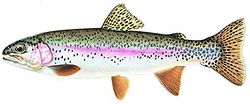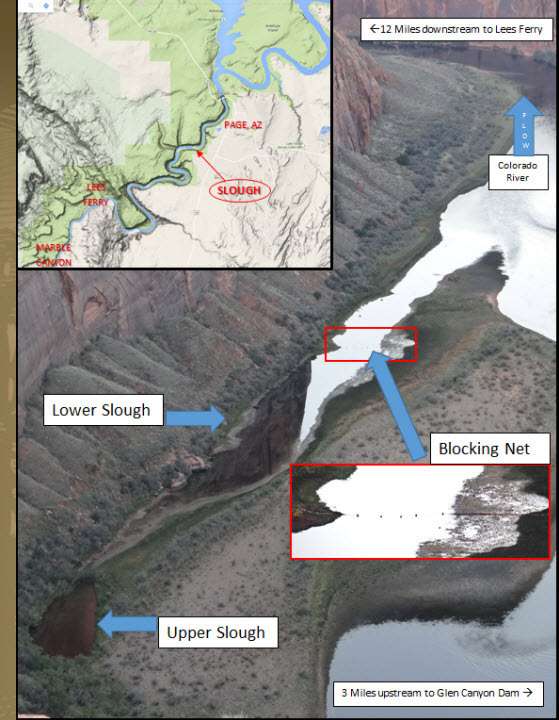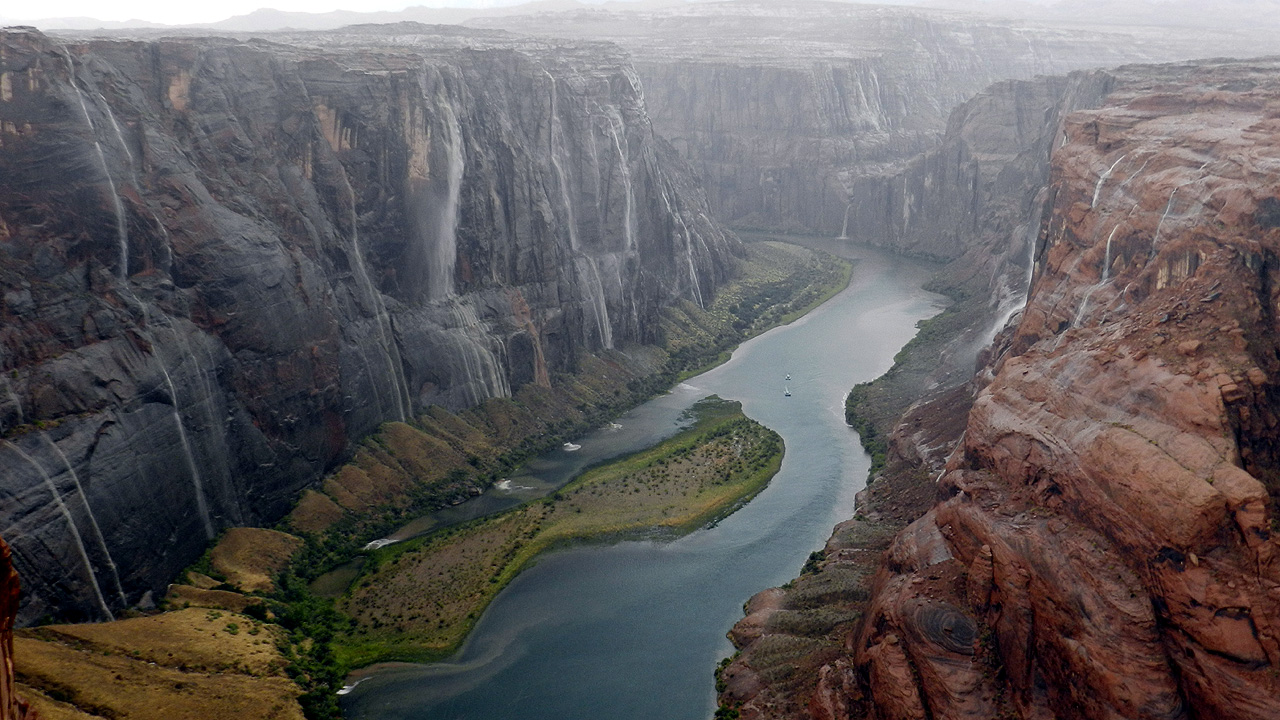Difference between revisions of "Green Sunfish Page"
Cellsworth (Talk | contribs) |
Cellsworth (Talk | contribs) |
||
| Line 129: | Line 129: | ||
Also note that the calculation below is a very conservative estimate, since this species is less likely to establish a population in a river environment than a lake or pond, also, the calculation assumes the fish are adult, which is not the case for the GSF in the sloughs - they are primarily young of year. If we do the calculation for the Colorado River below the sloughs, down to the Little Colorado River, which is our area of primary concern, and apply the minumum of 0.25 fish per surface acre, you get a result that 656 fish could establish a population. Given David Ward's calculation that we captured about 12% of the total number of GSF present on a single pass last year, that means a theoretical one-pass capture of 78 fish likely would represent a total population in the lower slough of 656 fish. Clay only captured 4 (counting the ones in the little channel) in 40 minutes of sampling, that should indicate that there were only about 33 fish present in the lower slough when Clay sampled. Subsequent sampling on Sept 1-2 only produced 10 GSF; much lower densities than this risk assessment would consider problematic Last year, in the lower slough, we removed about 1800 GSF before the treatment, and collected about 200 afterwards. AGFD suggested 100 fish as an upper limit, and Ken suggested 5 mature fish/hour electrofishing. These are both much more conservative targets than the above calculations. | Also note that the calculation below is a very conservative estimate, since this species is less likely to establish a population in a river environment than a lake or pond, also, the calculation assumes the fish are adult, which is not the case for the GSF in the sloughs - they are primarily young of year. If we do the calculation for the Colorado River below the sloughs, down to the Little Colorado River, which is our area of primary concern, and apply the minumum of 0.25 fish per surface acre, you get a result that 656 fish could establish a population. Given David Ward's calculation that we captured about 12% of the total number of GSF present on a single pass last year, that means a theoretical one-pass capture of 78 fish likely would represent a total population in the lower slough of 656 fish. Clay only captured 4 (counting the ones in the little channel) in 40 minutes of sampling, that should indicate that there were only about 33 fish present in the lower slough when Clay sampled. Subsequent sampling on Sept 1-2 only produced 10 GSF; much lower densities than this risk assessment would consider problematic Last year, in the lower slough, we removed about 1800 GSF before the treatment, and collected about 200 afterwards. AGFD suggested 100 fish as an upper limit, and Ken suggested 5 mature fish/hour electrofishing. These are both much more conservative targets than the above calculations. | ||
| − | In summary, I'd suggest that a very conservative value for the number of fish in the lower slough remaining before a triggered HFE would be 300 GSF of any size, about 50% of the value calculated from Martinez' analysis. This number would either be calculated from depletion estimates as we progress through the removal efforts, or by using 12% as the capture probability, thus a final pass should produce less than 36 total fish (12% of 300). | + | In summary, I'd suggest that a very conservative value for the number of fish in the lower slough remaining before a triggered HFE would be 300 GSF of any size, about 50% of the value calculated from Martinez' analysis. This number would either be calculated from depletion estimates as we progress through the removal efforts, or by using 12% as the capture probability, thus a final pass should produce less than 36 total fish (12% of 300). If the number of fish remaining in the lower slough after all mechanical removal efforts is greater than that, we would move towards implementing a rotenone treatment. |
| − | + | ||
| − | If the number of fish remaining in the lower slough after all mechanical removal efforts is greater than that, we would move towards implementing a rotenone treatment. | + | |
Please don't hesitate to call or email if you have questions or concerns. | Please don't hesitate to call or email if you have questions or concerns. | ||
Revision as of 16:24, 20 September 2016
|
Green Sunfish (Lepomis cyanellus)Description: Native to the Great Lakes, Hudson Bay and the Mississippi River basin. Introduced into Arizona in 1926. Large mouth with blue-green striations on the cheeks. Opercle flap is black with reddish or orange border. Bodies olive-green in color, dark vertical bars are faintly seen on sides. Pectoral fin short and rounded. Caudal fin and lower fin margins are white or yellowish with dusky spots at rear of dorsal and anal fins. Length: 3 to 12 inches. Weight: 3 ounces to 1 pound 8 ounces. May live to nine years. Location and Habitat: Found in most warm water lakes and streams in Arizona and even in a few trout lakes in the White Mountains and Mogollon Rim. Prefer lakes with rocky substrate and piles of rubble, but can be found around brushy banks and cliffs. Reproduction: Males build nests in shallow pools over gravel, sand or bedrock. The nests are usually within a couple feet of each other. The male guards the nest and hatched fry. Males constantly show defensive displays and fight with other males who come too close. Food: Green sunfish will eat anything they can catch and swallow. Aquatic and terrestrial insects and invertebrates are the most common food items. Small crayfish, fish and frogs are all in danger when green sunfish are present. Angling: Because of their highly predaceous and pugnacious nature they are one of the easiest fish to catch. They are always hungry and readily bite on small worms and insects. They readily take small jigs, spinners and spoons, as well as nymphs and small streamers. Green sunfish are great for teaching kids how to fish. |
 Rainbow Trout |
 Fish Species of the Colorado River in Lower Glen Canyon and Grand Canyon |
 Brown Trout |
|---|
|
|


